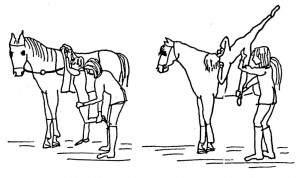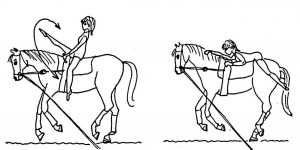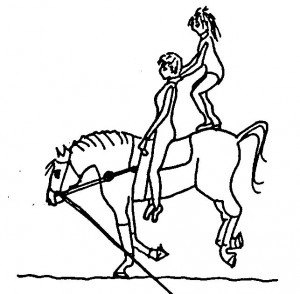Work on the Lunge Line – Part 18
|
|
Arbeit an der Longe – Teil 18
|
Lunging for Vaulting – the first exercises
- We will assume here that you have trained your horse on the lunge in all basic gaits and taught him to balance on the circle. So there are three additional things that your prospective vaulting horse must learn :
- that vaulters approach him while he moves and that this does not mean a request to stop, or a treat!
- that vaulters will mount him while he keeps running and then they will shift their weight in various ways – and this does not mean an aid as in riding, or a fall (and therefore not a request to stop)
- that more than one person might be on his back at one time.
- You should always use your most experienced vaulters for training a new vaulting horse. This series will concentrate on the lunging aspect and not teach you what the vaulters must do to act correctly – for this you must go to “Equestrian vaulting – a Handbook” or to my films “Equestrian vaulting” (both can be ordered through my website www.smarthorses.com).
- The first thing your horse must understand is that you want him to continually walk on his circle at an even pace, whether someone approaches him or not. When the first vaulter approaches along the lunge line, he will stop – expecting her to mount or give him a treat. In this case let your vaulter take him by the reins and make him walk on, while you help a bit with the whip. When the horse keeps going, let her grab one grip of the surcingle and pat him with the other hand, while walking along. Repeat until the horse has understood this, pat and praise him. Then the vaulter retreats to the centre (along the lunge line!) – the lunger keeps the horse going! Only later stop him, out on the circle, to then give him a treat in halt.
- If the horse is very confused while vaulters approach him, let them go only half way and retreat back to the centre, all the while reassuring the horse with a kind voice, until he keeps going reliably.
|
|
Longieren für Voltige – erste Übungen
- Wir setzen voraus, daß Sie Ihr Pferd in allen Grundgangarten an der Longe geschult und ihm Gleichgewicht auf dem Zirkel beigebracht haben. So gibt es noch drei zusätzliche Dinge, die Ihr zukünftiges Voltigepferd lernen muß:
- daß Voltigierer anlaufen werden, während es in Bewegung ist, und daß das keine Aufforderung zum Anhalten ist und kein Leckerli bedeutet!
- daß Voltigierer aufspringen werden, während es weiterläuft und daß sie dann ihr Gewicht verschieben werden – und daß dies keine Gewichtshilfe wie beim Reiten darstellt, auch keinen Sturz (und daher keine Aufforderung zum Halten)
- daß mehr als eine Person sich gleichzeitig auf seinem Rücken befinden wird.
- Benutzen Sie immer Ihre besten Voltigierer, um ein neues Pferd anzulernen. Diese Blogserie konzentriert sich auf den Aspekt des Longierens und lehrt daher nicht die Voiltigierer, wie sie es richtig machen müssen. Hierfür beachten Sie bitte das “Equestrian vaulting – a Handbook” oder meine Filme “Breitensport Voltige” (beide durch meine Website www.smarthorses.com zu bestellen).
- Das erste, was Ihr Pferd verstehen muß, ist, daß es auf seinem Kreis in regelmäßigem Schritt wietergehen soll, ob nun jemand herankommt oder nicht. Wenn der erste Voltigierer an der Longen entlang ankommt, wird es vermutlich stoppen – es erwartet ja, daß sie aufsteigt oder etwas füttert. Lassen Sie den Voltigierer das Pferd beim Zügel fassen und sacht weiterführen, während Sie mit der Peitsche ein wenig nachhelfen. Wenn es weiter läuft, soll der Voltigierer eine Hand am Griff haben und mit der anderen loben, während er mitläuft. Das macht man solange bis das Pferd verstanden hat, immer mit Lob. Dann zieht sich der Voltigierer zur Zirkelmitte hin zurück (wieder an der Longe entlang!) und der Longeur treibt sachte. Erst später halten wir an und füttern das Leckerli draußen auf dem Zirkel.
- Wenn das Pferd beim Anlaufen der Voltigierer sehr verwirrt ist, lassen Sie sie erst den halben Weg anlaufen und sich zurückziehen, immer mit Stimmhilfen, bis das Pferd verläßlich weiterläuft.
|
 The vaulter must approach AND retreat along the lunge line, always in full view for the horse.
Der Volti muss an der Longe entlang anlaufen UND sich zurück ziehen, immer voll im Blick des Pferdes.
|
- Once the horse tolerates this activity around him in walk without stopping, try it at trot. Make sure the vaulter approaches along the lunge line in direction of the horse’s shoulder and not from farther back, as this might put your horse into flight mode, running off. The horse must be able to plainly see the approaching vaulter, who should also announce herself by voice, if the horse is very nervous. Let her jog along and pat the horse, before falling back to the centre.
- All mounts in halt and walk should first happen with a correct “leg-up” to minimize discomfort to the horse (see handbook page 108 for the correct mounting technique).
|
|
- Wenn das Pferd das Anlaufen im Schritt verstanden hat üben sie es im Trab. Es ist wichtig, daß derVoltigierer an der Longe auf Richtung Schulter und nicht von weiter hinten anläuft, damit das Pferd sich nicht erschreckt. Es muß den Volti deutlich sehen können, der sich außerdem noch mit Stimme ankündigen kann, wenn das Pferd nervös ist. Er soll ein wenig mitlaufen und das Pferd streicheln, bevor er wieder zur Mitte zurückkehrt.
- Alle Aufsprünge in Halt und Schritt sollen mit einer Hilfestellung geschehen, damit sie dem Pferd nicht unangenehm sind (Seite 108 im Handbook erklärt die korrekte Technik).
|
 For mounting in halt and walk always use a pusher to minimize the discomfort to the horse and keep the gravity point of the vaulter over the grips. |
- The vaulter and pusher must be coordinated by counting out loud, so the weight shifts for the horse are minimal and the gravity point of the vaulter is over the grips, guaranteeing the landing on the horse’s back to be very soft.
- Once the vaulter is up, accustom the horse to gentle movements on his back by passing a leg over the front back and forth and with pauses of balanced seat in between. The horse receives lots of praise if he tolerates this without stopping! Remember that he is trying to be nice by stopping, when he feels the vaulter is falling – because that is how he might interpret these unexpected weight shifts. Get him used to dismounts by lifting a leg over the neck, so the lunger can keep him going while (and after!) the vaulter slides off! Be ready with voice and the whip in anticipation!
- Now the vaulters progress to more complex exercises such as the mill and kneeling. Make sure they show greatest consideration of the horse in all attempts!
- Once you feel that the horse is relaxing and accepts what is happening, you can start working in trot. As the weight shift of the vaulters are more pronounced in trot, the horse might again misunderstand you, as he cannot draw logical conclusions from his experiences in walk to those in trot! Also keep in mind what he can see: swinging legs, appearing at the edge of his vision may seem threatening – as flight animal he might spook. So be patient in teaching him to just keep going. Keep attempts short, stop and praise often.
- Anything which happens in the blind spot right behind the horse, such as approaches from behind and high dismounts to the back should be avoided in the beginning, as the horse might spook or kick out. Gradually increase the height of swings and dismounts – reassure him a lot!
- When on the horse, let the vaulters touch the horse everywhere, from neck to croup, always accompanied with pats and good words.
|
|
- Volti und Helfer müssen sich durch lautes Zählen koordinieren, damit die Gewichtsverschiebungen für das Pferd minimal ausfallen und der Schwerpunkt des Voltis über den Griffen ist, um eine weiche Landung auf dem Pferderücken zu garantieren.
- Wenn der Volti oben ist, gewöhnt man das Pferd an sanfte Bewegungen auf seinem Rücken, indem man hin und her ein Bein über seinen Hals führt, mit Pausen im ausbalancierten Sitz dazwischen. Wenn das Pferd dabei nicht anhält, viel loben! Vergessen Sie nicht, daß es ja lieb sein will, indem es stoppt, weil es denkt der Volti fällt runter – denn so mag es anfangs diese unerwarteten Gewichtsverschiebungen auslegen. Die ersten Abgänge sollen auch per Bein über den Hals geschehen, so daß der Longeur etwas treiben kann, während (und nachdem!) der Volti abgleitet! Setzen Sie Stimme und Peitsche früh genug ein!
- Nun können die Voltigierer zu komplexeren Übungen übergehen, z.B. Mühle und Knien. Bei allen Versuchen müssen sie größte Rücksicht auf das Pferd nehmen!
- Wenn das Pferd sich entspannt kann man auch das im Trab üben. Da die Gewichtsverschiebungen der Voltis stärker sein können, kann es nun wieder zu Mißverständnissen kommen, denn das Pferd kann nicht logisch von der Erfahrung im Schritt auf die im Trab schließen! Beachten Sie auch was es sehen kann: Füße, die plötzlich im Augenwinkel erscheinen können bedrohlich scheinen – und als Fluchttier kann es scheuen. Seien Sie also geduldig. Kurze Reprisen, oft Pausen, viel Lob!
- Alles was im toten Winkel direkt hinter dem Pferd passiert, ob Anlaufen oder hohe Abgänge nach hinten, sollten angangs vermieden werden, da das Pferd scheuen oder austreten könnte. Die Höhe der Schwünge und Abgänge wird nur allmählich gesteigert – mit viel Rückversicherung!
- Auf dem Pferd soll der Voltigierer das Pferd überall berühren, vom Hals bis zur Kruppe. All das ebenfalls mit Beruhigung und guten Worten.
|
 The horse is gently introduced to the idea that we intend to use his whole body from neck to croup.
Be ready for some small protest bucks – do not punish the horse for this!
Refer to “Equestrian Vaulting – a Handbook” for further instruction.
|
- Choose your most confident vaulters for the first double exercises, light ones if possible. When first standing on the croup, make sure they are aware of the horse’s sensitive areas and don’t poke their toes into his kidneys. A few little bucks in protest can be expected here – don’t punish the horse for this! Just ignore it and keep him going. Let the vaulter hang on to his helper securely and tell her to avoid crashing down on the horse’s back at all cost – rather to jump free to the outside. These first experiences are crucial for and remembered by the horse! If they are very uncomfortable, he will not want to become a vaulting horse!
|
|
- Für die ersten Doppelübungen wählen Sie Ihre selbstsichersten Voltis aus, und wenn möglich leichte. Beim ersten Stehen auf der Kruppe sollen diese die empfindlichen Stellen des Pferderückens genau kennen und nicht ihre Zehen in seine Nieren bohren. Ein paar kleine Protestbocker kann man hier schon erwarten – strafen Sie nicht dafür! Ignorieren Sie es einfach und treiben das Pferd zum Weiterlaufen an. Der Volti hält sich an seinem Helfer fest und muß nach Möglichkeit ein hartes Einsitzen auf dem Pferderücken vermeiden – es ist besser hier nach außen wegzuspringen! Diese ersten Erfahrungen merkt sich das Pferd! Wenn sie unangenehm sind, hat es keine Lust ein Voltigepferd zu werden!
|
 Use a light and confident vaulter for first try. Do not dig toes into the kidneys! Do not punish the horse for this first little protest !! |
- The progression from walk to trot to canter is clear: in each new gait assume again that the horse knows nothing – he cannot draw logical conclusions like humans! An exercise in canter is a new and different thing from one in walk, so you must begin at the beginning again!
- Keep in mind that it will be your fault, and definitely your loss, if your horse becomes “unsuitable” for vaulting! You must teach him in a way, which makes him feel good and each session worth it for the praise and treats received!
- Include many breaks and hand-changes – unhook the side-reins each time. A horse detest boredom just like we do, so offer him a good variety of other activities (see “Playing with Horses” for ideas! He will love all of them!)
Conclusion:
- It should be clear to you that lunging for a vaulting performance requires more reliance on your horse’s willing cooperation than any other type of lunge work. So be gentle and firm and above all clear in your demands. Don’t vent your frustrations on him or try to boss him around – this is not only about obedience! Your dependence on voice aids is great, as, with children in high exercises, you can’t apply sharp rein or whip aids without putting them into danger. Your attention must be unrelenting and with a new horse it is better if the lunger is not also the trainer of the vaulters at the same time. You must see trouble approaching before it happens, so your eyes must be on horse, vaulters and surroundings at the same time – this demands high concentration!
- For all other safety training hints for accident prevention please refer to the “Equestrian Vaulting – a Handbook for Vaulters and Trainers” or the films “Equestrian Vaulting” (order through the website www. smarthorses.com).
|
|
- Die Entwicklung vom Schritt zu Trab zu Galopp ist klar: in jeder neuen Gangart müssen Sie annehmen, daß das Pferd gar nichts weiß – es zieht keine logischen Rückschlüsse wie ein Mensch! Eine Übung im Galopp ist eine ganz andere Sache als im Schritt, so daß man immer wieder am Anfang anfangen muß!
- Bedenken Sie immer, daß es Ihre Schuld und definitiv Ihr Verlust ist, wenn das Pferd sich entschließt für die Voltige “ungeeignet” zu werden! Sie müssen es ihm in einer Weise nahebringen, die es nach jeder Übungsstunde befriedigt läßt, mit der Einstellung, daß es das Lob und die Leckerli wert war!
- Machen Sie viele Pausen und Handwechsel – jedesmal hängen Sie die Hilfszügel aus. Ein Pferd haßt Langeweile genau wie wir, also bieten Sie ihm auch viel Abwechslung mit anderen Aktivitäten (siehe “Playing with Horses” auch auf deutsch, mit vielen Ideen! Ihr Pferd wird begeistert sein!)
Zusammenfassung:
- Es sollte Ihnen klar sein, daß Longieren für eine Voltigevorstellung mehr williges Mitarbeiten von seiten Ihres Pferdes verlangt als andere Longenarbeit. Also seien Sie sanft, aber bestimmt und vor allem in Ihren Anforderungen klar verständlich. Lassen Sie nicht Ihren Frust an ihm aus und kommandieren es nicht herum – es dreht sich hier nicht nur um Gehorsam! Sie müssen sich oft auf Stimmhilfen verlassen können, wenn Kinder sich in hohen Übungen befinden und Sie keine scharfen Paraden oder Peitschenhilfen einsetzen können, ohne sie zu gefährden. Ihre Aufmerksamkeit muß unerbittlich sein. Mit einem grünen Pferd ist es auch besser, wenn der Longeur nicht gleichzeitig der Trainer der Kinder sein muß. Sie müssen Probleme erkennen, ehe sie passieren, und Ihre Augen müssen auf Pferd, Umgebung und Kindern gleichzeitig sein – das verlangt hohe Konzentration!
- Für alle anderen Sicherheitsvorkehrungen beim Training zur Unfallsvermeidung sehen Sie das “Equestrian Vaulting – a Handbook for Vaulters and Trainers” mit vielen Illustrationen und in leichtem Englisch geschrieben oder die Filme “Breitensport Voltige”. (Bestellung durch die Website www.smarthorses.com)
|
|
|
|
|





